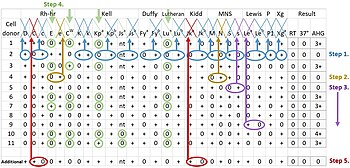Kell antigen system
| Kell protein | |||||||
|---|---|---|---|---|---|---|---|
| Identifiers | |||||||
| Symbol | KEL | ||||||
| Alt. symbols | ECE3, CD238 | ||||||
Chr. 7 q33 | |||||||
| |||||||
The Kell antigen system (also known as the Kell–Cellano system) is a
Protein
The KEL gene encodes a type II transmembrane
There are several
The Kell protein has also recently been designated CD238 (cluster of differentiation 238).
Disease association

Kell antigens are important in transfusion medicine, autoimmune hemolytic anemia and hemolytic disease of the newborn (anti-Kell). Anti-K is the next most common immune red cell antibody after those in the ABO and Rh system. Anti-K typically presents as IgG class alloantibody. Individuals lacking a specific Kell antigen may develop antibodies against Kell antigens when transfused with blood containing that antigen. This is particularly true for the "K" antigen which shows a relatively high antigenicity and moderately low frequency (~9%) in Caucasian populations. Anti-K can also occur following transplacental hemorrhage (TPH) associated with childbirth making Kell an important concern for hemolytic disease of the newborn. Following the formation of anti-K, subsequent blood transfusions may be marked by destruction of the new cells by these antibodies, a process known as hemolysis. Anti-K does not bind complement, therefore hemolysis is extravascular. Individuals without K antigens(K0) who have formed an antibody to a K antigen, must be transfused with blood from donors who are also K0 to prevent hemolysis.[citation needed]
McLeod phenotype
McLeod phenotype (or McLeod syndrome) is an
History
The Kell group was named after the first patient described with antibodies to K1, a pregnant woman named Mrs. Kellacher in 1945. King
Other associations
Evidence supports a genetic link between the Kell blood group (on chromosome 7 q33) and the ability to taste phenylthiocarbamide, or PTC, a bitter-tasting thiourea compound.[15][16] Bitter taste receptor proteins in the taste buds of the tongue that recognise PTC are encoded on nearby chromosome locus 7 q35-6.[citation needed]
References
- ISSN 1751-2816.
- PMID 7849312.
- PMID 10438732. Archived from the originalon 2013-04-14.
- ^ Russo DC, Lee S, Reid M, Redman CM. Topology of Kell blood group protein and the expression of multiple antigens by transfected cells. Blood. 1994 Nov 15;84(10):3518-23.
- ^ Russo DC, Redman C, Lee S. Association of XK and Kell blood group proteins. J Biol Chem. 1998 May 29;273(22):13950-6.
- ^ "Entrez Gene: KEL".
- S2CID 41663851.
- PMID 11134029.
- PMID 8623782.
- ^ Coombs RRA, Mourant AE, Race RR. A new test for the detection of weak and incomplete Rh agglutinins. Br J Exp Pathol 1945;26:255
- S2CID 4187507.
- S2CID 30275809.
- S2CID 159499333.
- PMID 24350322.
- PMID 4435792.
- PMID 976995.
External links
- Online Mendelian Inheritance in Man (OMIM): 110900 - OMIM entry for Kell protein
- Online Mendelian Inheritance in Man (OMIM): 314850 - OMIM entry for XK protein
- Kell at NIH
- KEL+protein,+human at the U.S. National Library of Medicine Medical Subject Headings (MeSH)
